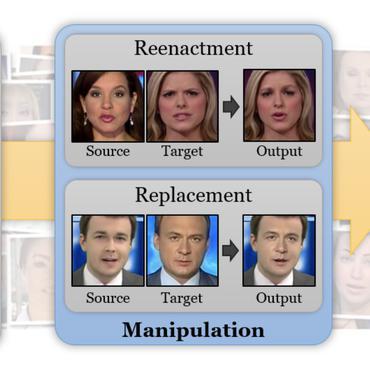Fake Image Detection
11 papers with code • 0 benchmarks • 2 datasets
( Image credit: FaceForensics++ )
Benchmarks
These leaderboards are used to track progress in Fake Image Detection
Most implemented papers
FaceForensics++: Learning to Detect Manipulated Facial Images
In particular, the benchmark is based on DeepFakes, Face2Face, FaceSwap and NeuralTextures as prominent representatives for facial manipulations at random compression level and size.
MesoNet: a Compact Facial Video Forgery Detection Network
This paper presents a method to automatically and efficiently detect face tampering in videos, and particularly focuses on two recent techniques used to generate hyper-realistic forged videos: Deepfake and Face2Face.
ManTra-Net: Manipulation Tracing Network for Detection and Localization of Image Forgeries With Anomalous Features
To fight against real-life image forgery, which commonly involves different types and combined manipulations, we propose a unified deep neural architecture called ManTra-Net.
Video Face Manipulation Detection Through Ensemble of CNNs
In this paper, we tackle the problem of face manipulation detection in video sequences targeting modern facial manipulation techniques.
Learning to Detect Fake Face Images in the Wild
Although Generative Adversarial Network (GAN) can be used to generate the realistic image, improper use of these technologies brings hidden concerns.
Global Texture Enhancement for Fake Face Detection in the Wild
In this paper, we conduct an empirical study on fake/real faces, and have two important observations: firstly, the texture of fake faces is substantially different from real ones; secondly, global texture statistics are more robust to image editing and transferable to fake faces from different GANs and datasets.
FakePolisher: Making DeepFakes More Detection-Evasive by Shallow Reconstruction
At this moment, GAN-based image generation methods are still imperfect, whose upsampling design has limitations in leaving some certain artifact patterns in the synthesized image.
Learning on Gradients: Generalized Artifacts Representation for GAN-Generated Images Detection
The key of fake image detection is to develop a generalized representation to describe the artifacts produced by generation models.
Parents and Children: Distinguishing Multimodal DeepFakes from Natural Images
Recent advancements in diffusion models have enabled the generation of realistic deepfakes by writing textual prompts in natural language.
Unveiling the Truth: Exploring Human Gaze Patterns in Fake Images
Creating high-quality and realistic images is now possible thanks to the impressive advancements in image generation.

 ArtiFact
ArtiFact
 Corn Seeds Dataset
Corn Seeds Dataset

